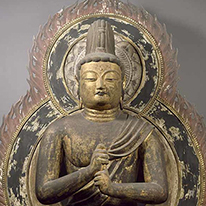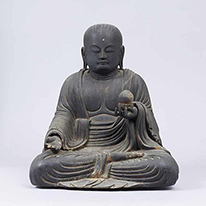Past Exhibitions
- Japanese Sculpture
- June 12, 2018 - September 9, 2018
What do Japanese sculptures depict? Before the Edo period, almost all Japanese statues were of deities or religious figures. Buddhist sculptures have been produced in Japan since Buddhism came to the archipelago in the seventh century. Japanese Buddhist deities often have origins in South Asia and the Himalayas. These were usually imported into Japan by way of China, bringing foreign influences with them.
One of the distinctive characteristics of Japanese sculpture is its use of wood as a primary material. Various modes of carving and other techniques—including joint-block construction (yosegi-zukuri) and inlaid crystal eyes—were developed in Japan to create these wood images.
The Japanese Buddhist sculptures on view here come from different historical periods. Their varied styles exemplify the repeated waves of influence from the Asian mainland as well as subsequent Japanese innovations.
- Deities of Buddhist Hell: King Enma and Jizō
- June 12, 2018 - September 9, 2018
One of the main events of summer in Japan is Obon (or Bon), a period of three days in mid-August (or mid-July in some regions) when the spirits of the dead are said to come back to earth. The roots of this custom come from Ullambana (J: urabon-e), an ancient Indian festival for the dead. During Obon, Japanese families typically gather together and visit their ancestral graves. Obon is also the time when the cauldrons of hell supposedly open.
In Japanese Buddhism, the King of Hell is Enma, who is derived from the Hindu deity Yama. When Buddhism went from India to China, Enma—under the influence of Taoism—was incorporated into a group of deities called the Ten Kings, whose judgement determines one’s fate in the afterlife. In Japan, the Ten Kings were further associated with Jizō (Ksitigharba), a bodhisattva in the guise of a monk who has the power to rescue those sent to hell.
This exhibition features the Ten Kings sculptures from Jōnen-ji Temple along with various representations of Jizō, large and small, representing Japanese fears and hopes about the afterworld.













